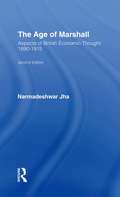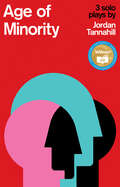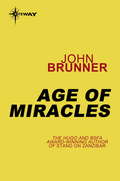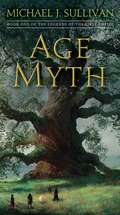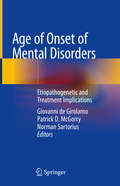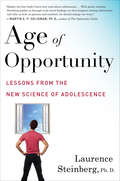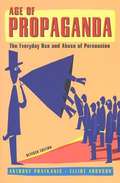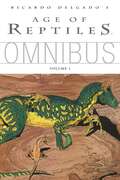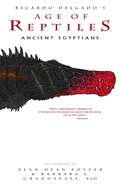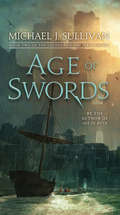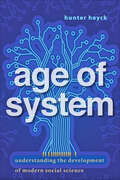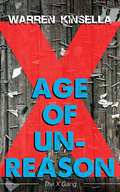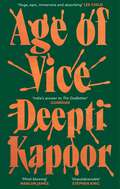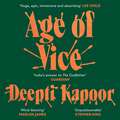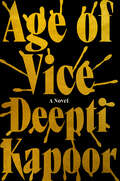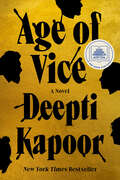- Table View
- List View
Age of Louis XIV: The Rise of Modern Diplomacy
by William James RoosenWilliam James Roosen has written the first general study of European diplomacy in the age of Louis XIV which is based on the actual practices and institutions of that era, rather than on the writing of early theoreticians.Though the seventeenth century may not have been a period of great innovations in international diplomacy, it provides us with an important illustration of the "workings of a system which was well suited to the gradually changing needs of its time" and which has been called "the best form of diplomacy ever developed."Dr. Roosen demonstrates both the obvious differences and the many similarities between diplomatic procedures and practices of the seventeenth century and the twentieth. Any student of diplomacy and international relations will gain valuable insight and understanding from this study of the early modern diplomatic personalities, institutions, and practices.One of Dr. Roosen's goals in writing this book has been to discover the relationships between the ideological and socioeconomic structures and the diplomatic personalities who have influenced modern diplomacy. Further, he supplies the only available study of the realities of diplomatic practices in seventeenth century Europe, and provides an excellent basis for comparison with twentieth century international relations, in the hope that "studying early modern diplomatic personalities, institutions and practices should increase our understanding of international relations today."There are chapters on "The States of Europe," "Kings and Ministers," "Ambassadors," "Second Class Diplomats," "A Typical Early Modern Embassy," "Information: Important Objective of Diplomatic Activity," and "The Variety of Diplomatic Duties.
Age of Marshall: Aspects of British Economic Thought
by Narmedeshwar JhaFirst published in 1973. This is the second edition and nine years after when The Age of Marshall was first published. The period 1890-1915 in the history of British Economic Thought may aptly be described as the Age of Marshall. His influence as teacher, and his ideas as presented in the Principles of Economics (1890) and other writings, stimulated and often dominated the ideas and writings of most of the younger economists of the period. His ideas also provided a theoretical basis for increasing state intervention in economic life of the community in Britain and thus helped the Liberal Government of Great Britain lay the foundations of a Welfare State.
Age of Minority: Three Plays by Jordan Tannahill
by Jordan TannahillBased on a true story, Get Yourself Home Skyler James follows the harrowing journey of a young lesbian who defects from the army when she is outed by fellow soldiers. Peter Fechter: 52 Minutes chronicles the last hour of Peter Fechter's life, a teenager in East Berlin shot while attempting to cross the Berlin Wall in 1962 with his companion. Finally, rihannaboi95 centres around a Toronto teen whose world comes crashing in when YouTube videos of him dancing to songs by his favourite pop heroine go viral. Together these solo plays explore the lives of three queer youth and their resilience in the face of violence and intolerance.
Age of Miracles
by John BrunnerWhen suddenly all the fissionable material on Earth was exploded, Earthmen had their first notice of the aliens' arrival. And by the time the panic, death and chaos had been sorted out, reports were coming in about mysterious cities scattered across the face of the planet - huge areas of flickering light and awesome free energy, disorienting to human senses and impregnable to attack. The question was: were they alien bases . . . or something else?
Age of Miracles
by John BrunnerWhen suddenly all the fissionable material on Earth was exploded, Earthmen had their first notice of the aliens' arrival. And by the time the panic, death and chaos had been sorted out, reports were coming in about mysterious cities scattered across the face of the planet - huge areas of flickering light and awesome free energy, disorienting to human senses and impregnable to attack. The question was: were they alien bases...or something else?
Age of Myth: Book One of The Legends of the First Empire (The Legends of the First Empire #1)
by Michael J. SullivanMichael J. Sullivan's trailblazing career began with the breakout success of his Riyria series: full-bodied, spellbinding fantasy adventures whose imaginative scope and sympathetic characters won a devoted readership and comparisons to fantasy masters Brandon Sanderson, Scott Lynch, and J.R.R. Tolkien himself. Now Sullivan's stunning hardcover debut, Age of Myth, inaugurates an original five-book series--and one of fantasy's finest next-generation storytellers continues to break new ground. Since time immemorial, humans have worshipped the gods they call Fhrey, truly a race apart: invincible in battle, masters of magic, and seemingly immortal. But when a god falls to a human blade, the balance of power between humans and those they thought were gods changes forever. Now only a few stand between humankind and annihilation: Raithe, reluctant to embrace his destiny as the God Killer; Suri, a young seer burdened by signs of impending doom; and Persephone, who must overcome personal tragedy to lead her people. The Age of Myth is over. The time of rebellion has begun.Praise for Michael J. Sullivan "Hair-raising escapes, flashy sword fights, and faithful friendship complete the formula for good old-fashioned escapist fun."--Publishers Weekly, on Theft of Swords "Filled with adventure and clever dialog and featuring a pair of not-quite-heroes whose loyalties to each other provide them with their greatest strength, this epic fantasy showcases the arrival of a master storyteller."--Library Journal, on Theft of Swords "With less gore and a smaller cast of characters than George R. R. Martin's Song of Ice and Fire but equally satisfying, Sullivan's epic fantasy will be gaining fans at exponential rates."--Library Journal, on The Rose and the ThornFrom the Hardcover edition.
Age of Onset of Mental Disorders: Etiopathogenetic and Treatment Implications
by Norman Sartorius Giovanni De Girolamo Patrick D. McGorryThis book presents a thorough and critical review of current knowledge about the age of onset of mental disorders. The opening chapters offer information about the impact of the age of onset on the clinical picture, course, and outcome of physical illnesses, and about the neurobiological implications and correlates of different ages of onset. The impact and correlates of the ages of onset of all the most important mental disorders are then discussed in detail by internationally renowned scientists. The background to the book is the recognition that a better understanding of age of onset makes it possible to estimate the lifetime risk of disorders, helps to elucidate pathogenesis, and facilitates efficient, targeted clinical management. The book will be of value for clinicians, mental health professionals, mental health researchers, epidemiologists, and different stakeholders in the mental health field.
Age of Opportunity
by Laurence SteinbergA leading authority draws on new research to explain why the adolescent years are so developmentally crucial, and what we must do to raise happier, more successful kids.Adolescence now lasts longer than ever before. And as world-renowned expert on adolescent psychology Dr. Laurence Steinberg argues, this makes these years the key period in determining individuals' life outcomes, demanding that we change the way we parent, educate, and understand young people.In Age of Opportunity, Steinberg leads readers through a host of new findings -- including groundbreaking original research -- that reveal what the new timetable of adolescence means for parenting 13-year-olds (who may look more mature than they really are) versus 20-somethings (who may not be floundering even when it looks like they are). He also explains how the plasticity of the adolescent brain, rivaling that of years 0 through 3, suggests new strategies for instilling self-control during the teenage years. Packed with useful knowledge, Age of Opportunity is a sweeping book in the tradition of Reviving Ophelia, and an essential guide for parents and educators of teenagers.
Age of Oprah: Cultural Icon for the Neoliberal Era (Media and Power)
by Janice PeckOver the last two decades Oprah Winfrey's journey has taken her from talk show queen to-as Time Magazine has asserted-"one of the most important figures in popular culture." Through her talk show, magazine, website, seminars, charity work, and public appearances, her influence in the social, economic, and political arenas of American life is considerable and until now, largely unexamined. In The Age of Oprah, media scholar and journalist Janice Peck traces Winfrey's growing cultural impact and illustrates the fascinating parallels between her road to fame and fortune and the political-economic rise of neoliberalism in this country. While seeking to understand Oprah's ascent to the near- iconic status that she enjoys today, Peck's book provides a fascinating window into the intersection of American politics and culture over the past quarter century.
Age of Propaganda: The Everyday Use and Abuse of Persuasion
by Elliot Aronson Anthony H. PratkanisAmericans create 57% of the world's advertising while representing only 6% of its population; half of our waking hours are spent immersed in the mass media. Persuasion has always been integral to the democratic process, but increasingly, thoughtful discussion is being replaced with simplistic soundbites and manipulative messages. Drawing on the history of propaganda as well as on contemporary research in social psychology, Age of Propaganda shows how the tactics used by political campaigners, sales agents, advertisers, televangelists, demagogues, and others often take advantage of our emotions by appealing to our deepest fears and most irrational hopes, creating a distorted vision of the world we live in. This revised and updated edition includes coverage of the Clinton/Lewinsky scandal, recent election campaigns, talk radio, teen suicide, U. F. O. abductions, the Columbine shootings, and novel propaganda tactics based on hypocrisy and false allegations.
Age of Reptiles Omnibus: Volume 1 (Age of Reptiles)
by Ricardo DelgadoWhen Ricardo Delgado—a prolific development and storyboard artist who has worked on such hit films as Men in Black, The Incredibles, WALL-E, X—Men Origins: Wolverine, and the Matrix series—first set his sights on creating comics, he crafted an epic tale about the most unlikely cast of characters: dinosaurs. Since that first foray into the world of sequential art—which earned him an Eisner win for Talent Deserving of Wider Recognition—he has returned to his critically acclaimed Age of Reptiles again and again, each time crafting a captivating saga about his saurian subjects.* This volume collects the long—out—of—print Age of Reptiles and Age of Reptiles: The Hunt, and the never—before—collected third series, Age of Reptiles: The Journey."Delgado once more proves that the age of great illustration is alive and well." —John Landis, Filmmaker, An American Werewolf in London, Michael Jackson's Thriller
Age of Reptiles: Ancient Egyptians
by Ricardo DelgadoOne of the most beloved and respected comic book series returns as Ricardo Delgado's Age of Reptiles: Ancient Egyptians series marks a bold, new direction in wordless storytelling. The steaming swamps of Cretaceous Africa teem with prehistoric life and primordial danger in a tale filled with villains, victims, and one of the most dangerous and unpredictable protagonists ever created. Watch the lone, lonely anti-hero Spinosaurus Aegypticus as he faces a swamp full of dangerous, double-crossing dinosaurs in a plot-twisting parable that will remind you of the classic spaghetti western and the noble samurai tales of yore.
Age of Revolutions: Progress and Backlash from 1600 to the Present
by Fareed ZakariaThe CNN host and best-selling author explores the revolutions—past and present—that define the polarized and unstable age in which we live. <p><p> Populist rage, ideological fracture, economic and technological shocks, war, and an international system studded with catastrophic risk—the early decades of the twenty-first century may be the most revolutionary period in modern history. But it is not the first. Humans have lived, and thrived, through more than one great realignment. What are these revolutions, and how can they help us to understand our fraught world? <p><p> In this major work, Fareed Zakaria masterfully investigates the eras and movements that have shaken norms while shaping the modern world. Three such periods hold profound lessons for today. First, in the seventeenth-century Netherlands, a fascinating series of transformations made that tiny land the richest in the world—and created politics as we know it today. Next, the French Revolution, an explosive era that devoured its ideological children and left a bloody legacy that haunts us today. Finally, the mother of all revolutions, the Industrial Revolution, which catapulted Great Britain and the US to global dominance and created the modern world. <p><p> Alongside these paradigm-shifting historical events, Zakaria probes four present-day revolutions: globalization, technology, identity, and geopolitics. For all their benefits, the globalization and technology revolutions have produced profound disruptions and pervasive anxiety and our identity. And increasingly, identity is the battlefield on which the twenty-first century’s polarized politics are fought. All this is set against a geopolitical revolution as great as the one that catapulted the United States to world power in the late nineteenth century. Now we are entering a world in which the US is no longer the dominant power. As we find ourselves at the nexus of four seismic revolutions, we can easily imagine a dark future. But Zakaria proves that pessimism is premature. If we act wisely, the liberal international order can be revived and populism relegated to the ash heap of history. <p><p> As few public intellectuals can, Zakaria combines intellectual range, deep historical insight, and uncanny prescience to once again reframe and illuminate our turbulent present. His bold, compelling arguments make this book essential reading in our age of revolutions. <p> <b>New York Times Bestseller</b>
Age of Secession
by Griffiths Ryan D.What are the factors that determine how central governments respond to demands for independence? Secessionist movements are numerous and quite varied in form, but the chief obstacle to their ambitions is the state itself, which can deny independence demands, deploy force if need be, and request that the international community respect its territorial integrity by not recognizing the breakaway region. Age of Secession focuses on this crucial but neglected moment in the life of a secessionist movement. Griffiths offers a novel theory using original data on secessionist movements between 1816 and 2011. He explains how state response is shaped by international and domestic factors, when conflict is likely, and why states have proliferated since 1945. He mixes quantitative methods with case studies of secessionist movements in the United Kingdom, Russia/Soviet Union, and India. This is an important book for anyone who wants to understand the phenomenon of secession.
Age of Shōjo: The Emergence, Evolution, and Power of Japanese Girls' Magazine Fiction
by Hiromi Tsuchiya DollaseHiromi Tsuchiya Dollase examines the role that magazines have played in the creation and development of the concept of shōjo, the modern cultural identity of adolescent Japanese girls. Cloaking their ideas in the pages of girls' magazines, writers could effectively express their desires for freedom from and resistance against oppressive cultural conventions, and their shōjo characters' "immature" qualities and social marginality gave them the power to express their thoughts without worrying about the reaction of authorities. Dollase details the transformation of Japanese girls' fiction from the 1900s to the 1980s by discussing the adaptation of Western stories, including Louisa May Alcott's Little Women, in the Meiji period; the emergence of young female writers in the 1910s and the flourishing girls' fiction era of the 1920s and 1930s; the changes wrought by state interference during the war; and the new era of empowered postwar fiction. The book highlights seminal author Yoshiya Nobuko's dreamy fantasies and Kitagawa Chiyo's social realism, Morita Tama's autobiographical feminism, the contributions of Nobel Prize–winning author Kawabata Yasunari, and the humorous modern fiction of Himuro Saeko and Tanabe Seiko. Using girls' perspectives, these authors addressed social topics such as education, same-sex love, feminism, and socialism. The age of shōjo, which began at the turn of the twentieth century, continues to nurture new generations of writers and entice audiences beyond age, gender, and nationality.
Age of Swords: Book Two of The Legends of the First Empire
by Michael J. SullivanThe gods have been proven mortal and new heroes will arise as the battle continues in the sequel to Age of Myth—from the author of the Riyria Revelations and Riyria Chronicles series.In Age of Myth, fantasy master Michael J. Sullivan launched readers on an epic journey of magic and adventure, heroism and betrayal, love and loss. Now the thrilling saga continues as the human uprising is threatened by powerful enemies from without—and bitter rivalries from within. Raithe, the God Killer, may have started the rebellion by killing a Fhrey, but long-standing enmities dividing the Rhunes make it all but impossible to unite against the common foe. And even if the clans can join forces, how will they defeat an enemy whose magical prowess renders them indistinguishable from gods? The answer lies across the sea in a faraway land populated by a reclusive and dour race who feel nothing but disdain for both Fhrey and mankind. With time running out, Persephone leads the gifted young seer Suri, the Fhrey sorceress Arion, and a small band of misfits in a desperate search for aid—a quest that will take them into the darkest depths of Elan. There, an ancient adversary waits, as fearsome as it is deadly.Don’t miss any of Michael J. Sullivan’s Legends of the First Empire novels: AGE OF MYTH | AGE OF SWORDS (Coming soon!) Praise for Michael J. Sullivan “If you enjoy epic fantasy, and are perhaps hungering for something with timeless appeal, then I highly recommend picking up Age of Myth.”—The BiblioSanctum, on Age of Myth “Hair-raising escapes, flashy sword fights, and faithful friendship complete the formula for good old-fashioned escapist fun.”—Publishers Weekly, on Theft of Swords “Filled with adventure and clever dialog and featuring a pair of not-quite-heroes whose loyalties to each other provide them with their greatest strength, this epic fantasy showcases the arrival of a master storyteller.”—Library Journal, on Theft of Swords “With less gore and a smaller cast of characters than George R. R. Martin’s Song of Ice and Fire but equally satisfying, Sullivan’s epic fantasy will be gaining fans at exponential rates.”—Library Journal, on The Rose and the Thorn
Age of System: Understanding the Development of Modern Social Science
by Hunter HeyckIn the years after World War II, a new generation of scholars redefined the central concepts and practices of social science in America.Before the Second World War, social scientists struggled to define and defend their disciplines. After the war, "high modern" social scientists harnessed new resources in a quest to create a unified understanding of human behavior—and to remake the world in the image of their new model man.In Age of System, Hunter Heyck explains why social scientists—shaped by encounters with the ongoing "organizational revolution" and its revolutionary technologies of communication and control—embraced a new and extremely influential perspective on science and nature, one that conceived of all things in terms of system, structure, function, organization, and process. He also explores how this emerging unified theory of human behavior implied a troubling similarity between humans and machines, with freighted implications for individual liberty and self-direction. These social scientists trained a generation of decision-makers in schools of business and public administration, wrote the basic textbooks from which millions learned how the economy, society, polity, culture, and even the mind worked, and drafted the position papers, books, and articles that helped set the terms of public discourse in a new era of mass media, think tanks, and issue networks. Drawing on close readings of key texts and a broad survey of more than 1,800 journal articles, Heyck follows the dollars—and the dreams—of a generation of scholars that believed in "the system." He maps the broad landscape of changes in the social sciences, focusing especially intently on the ideas and practices associated with modernization theory, rational choice theory, and modeling. A highly accomplished historian, Heyck relays this complicated story with unusual clarity.
Age of Unreason (Star Trek #26)
by Scott CiencinIn the wake of the catastrophic events of Wildfire, Carol Abramowitz, Bart Faulwell, and Soloman are sent on a special mission to Vrinda, where the S.C.E. must introduce new technology to the world while avoiding getting embroiled in the political struggle between the Nasnan and the rival Tirza Sirajaldin. But first Abramowitz must participate in a ritual involving the expression of honest, naked emotion -- one that has already been botched by Martin Mansur, the previous Federation representative, who is also a rival from Abramowitz's past. Never particularly comfortable expressing her emotions, Abramowitz must confront her own personal difficulties, and also confront Mansur, even as Tirza Sirajaldin saboteurs threaten the project's very existence....
Age of Unreason (Star Trek: Starfleet Corps Of Engineers Ser. #26)
by Scott CiencinIn the wake of the catastrophic events of Wildfire, Carol Abramowitz, Bart Faulwell, and Soloman are sent on a special mission to Vrinda, where the S.C.E. must introduce new technology to the world while avoiding getting embroiled in the political struggle between the Nasnan and the rival Tirza Sirajaldin. But first Abramowitz must participate in a ritual involving the expression of honest, naked emotion -- one that has already been botched by Martin Mansur, the previous Federation representative, who is also a rival from Abramowitz's past. Never particularly comfortable expressing her emotions, Abramowitz must confront her own personal difficulties, and also confront Mansur, even as Tirza Sirajaldin saboteurs threaten the project's very existence....
Age of Unreason: The X Gang (The X Gang #3)
by Warren KinsellaThe X Gang must stand up for their beliefs in a changing world. A new face of violence and hate has come to Portland, Maine, and the punks in the X Gang find themselves targeted once again. It is the early eighties, and the youth subculture they have grown up in is changing. Kurt, X, and the others have reluctantly concluded that they are unlikely to ever change the world with their punk anthems, but that injustice is still worth fighting against. The friends lean on each other for the strength to deal with death, addiction, sexism, and racism they see all around them. Meanwhile, the police and the FBI are on the trail of a killer, and a member of the X Gang holds the secret to the fugitive’s sinister motivations. Age of Unreason tells the shocking story of how hatred can become a cause, and how we must stand together against it no matter the cost.
Age of Vice
by Deepti KapoorThis is the age of vice, where pleasure and power are everything, and the family ties that bind can also killNew Delhi, 3 a.m. A speeding Mercedes jumps the kerb, and in the blink of an eye five people are dead. It's a rich man's car, but when the dust settles there is no rich man at all, just a shell-shocked servant who cannot explain the strange series of events that led to this crime. Nor can he foresee the dark drama that is about to unfold.Deftly shifting through time and perspective in contemporary India, Age of Vice is an epic, action-packed story propelled by the seductive wealth, startling corruption, and bloodthirsty violence of the Wadia family-loved by some, loathed by others, feared by all.In the shadow of lavish estates, extravagant parties, predatory business deals, and calculated political influence, three lives become dangerously intertwined: Ajay is the watchful servant, born into poverty, who rises through the family's ranks. Sunny is the playboy heir who dreams of outshining his father, whatever the cost. And Neda is the curious journalist caught between morality and desire. Against a sweeping plot fueled by loss, pleasure, greed, yearning, violence, and revenge, will these characters' connections become a path to escape, or a trigger of further destruction?Equal parts crime thriller and family saga, transporting readers from the dusty villages of Uttar Pradesh to the urban energy of New Delhi, Age of Vice is an intoxicating novel of gangsters and lovers, false friendships, forbidden romance, and the consequences of corruption. It is binge-worthy entertainment at its literary best.
Age of Vice: 'The story is unputdownable . . . This is how it's done when it's done exactly right' Stephen King
by Deepti KapoorHIGHLY ANTICIPATED OPRAH DAILY PICK FOR 2023'Ill-fated love and toxic family power struggles provide emotional drive for this big dynastic saga' JAKE ARNOTT, GUARDIAN 'Huge, epic, immersive and absorbing . . . certain to be a book of the year' LEE CHILD, NEW YORK TIMES BESTSELLING AUTHOR 'Kapoor's violent and bitter story is deeply addictive' PUBLISHERS WEEKLY (STARRED REVIEW)This is the age of vice, where pleasure and power are everything, and the family ties that bind can also killNew Delhi, 3 a.m. A speeding Mercedes jumps the kerb, and in the blink of an eye five people are dead. It's a rich man's car, but when the dust settles there is no rich man at all, just a shell-shocked servant who cannot explain the strange series of events that led to this crime. Nor can he foresee the dark drama that is about to unfold.Deftly shifting through time and perspective in contemporary India, Age of Vice is an epic, action-packed story propelled by the seductive wealth, startling corruption, and bloodthirsty violence of the Wadia family-loved by some, loathed by others, feared by all.In the shadow of lavish estates, extravagant parties, predatory business deals, and calculated political influence, three lives become dangerously intertwined: Ajay is the watchful servant, born into poverty, who rises through the family's ranks. Sunny is the playboy heir who dreams of outshining his father, whatever the cost. And Neda is the curious journalist caught between morality and desire. Against a sweeping plot fueled by loss, pleasure, greed, yearning, violence, and revenge, will these characters' connections become a path to escape, or a trigger of further destruction?Equal parts crime thriller and family saga, transporting readers from the dusty villages of Uttar Pradesh to the urban energy of New Delhi, Age of Vice is an intoxicating novel of gangsters and lovers, false friendships, forbidden romance, and the consequences of corruption. It is binge-worthy entertainment at its literary best.
Age of Vice: A Novel
by Deepti KapoorThis is the age of vice, when money, pleasure and power are everything, and the family ties that bind can also killNew Delhi, 3 a.m. A speeding Mercedes jumps the curb and in the blink of an eye, five people are dead. It’s a rich man’s car, but when the dust settles there is no rich man at all, just a shell-shocked servant who can’t explain the strange series of events that led to this crime, or foresee the dark drama that is about to unfold.Deftly shifting through time and perspective in contemporary India, Age of Vice is an epic, action-packed story propelled by the seductive wealth, startling corruption and bloodthirsty violence of the Wadia family—loved by some, loathed by others, feared by all. In the shadow of lavish estates, extravagant parties, predatory business deals and calculated political influence, three lives become dangerously intertwined. Born into poverty, Ajay is the watchful servant who rises through the family’s ranks. Sunny is the playboy heir who dreams of outshining his father, whatever the cost. And Neda is the curious journalist caught between morality and desire. Against a sweeping plot fueled by loss, yearning, violence and revenge, will these characters’ connections become a path to escape or a trigger for further destruction? Equal parts crime thriller and family saga, Age of Vice transports readers from the dusty villages of Uttar Pradesh to the urban energy of New Delhi. An intoxicating novel of gangsters and lovers, false friendships, forbidden romance and the consequences of corruption, it is binge-worthy entertainment at its literary best.
Age of Vice: A Novel
by Deepti KapoorA GOOD MORNING AMERICA BOOK CLUB PICK&“Dazzling...Finally free from the book&’s grip, now all I want to do is get others hooked.&”— The Washington Post "Sensationally good — huge, epic, immersive and absorbing ... certain to be a book of the year." —Lee ChildThis is the age of vice, where money, pleasure, and power are everything, and the family ties that bind can also kill. New Delhi, 3 a.m. A speeding Mercedes jumps the curb and in the blink of an eye, five people are dead. It&’s a rich man&’s car, but when the dust settles there is no rich man at all, just a shell-shocked servant who cannot explain the strange series of events that led to this crime. Nor can he foresee the dark drama that is about to unfold. Deftly shifting through time and perspective in contemporary India, Age of Vice is an epic, action-packed story propelled by the seductive wealth, startling corruption, and bloodthirsty violence of the Wadia family -- loved by some, loathed by others, feared by all. In the shadow of lavish estates, extravagant parties, predatory business deals and calculated political influence, three lives become dangerously intertwined: Ajay is the watchful servant, born into poverty, who rises through the family&’s ranks. Sunny is the playboy heir who dreams of outshining his father, whatever the cost. And Neda is the curious journalist caught between morality and desire. Against a sweeping plot fueled by loss, pleasure, greed, yearning, violence and revenge, will these characters&’ connections become a path to escape, or a trigger of further destruction? Equal parts crime thriller and family saga, transporting readers from the dusty villages of Uttar Pradesh to the urban energy of New Delhi, Age of Vice is an intoxicating novel of gangsters and lovers, false friendships, forbidden romance, and the consequences of corruption. It is binge-worthy entertainment at its literary best.
Age of War: Book Three Of The Legends Of The First Empire (The Legends of the First Empire #3)
by Michael J. SullivanThe epic battle between humankind and their godlike rulers finally ignites in the masterful follow-up to Age of Myth and Age of Swords. The alliance of humans and renegade Fhrey is fragile—and about to be tested as never before. Persephone keeps the human clans from turning on one another through her iron will and a compassionate heart. The arrogant Fhrey are barely held in check by their leader, Nyphron, who seeks to advance his own nefarious agenda through a loveless marriage that will result in the betrayal of the person Persephone loves most: Raithe, the God Killer. As the Fhrey overlords marshal their army and sorcerers to crush the rebellion, old loyalties will be challenged while fresh conspiracies will threaten to undo all that Persephone has accomplished. In the darkest hour, when hope is all but lost, new heroes will rise . . . but at what terrible cost?Magic, fantasy, and mythology collide in Michael J. Sullivan’s Legends of the First Empire series:AGE OF MYTH • AGE OF SWORDS • AGE OF WAR

